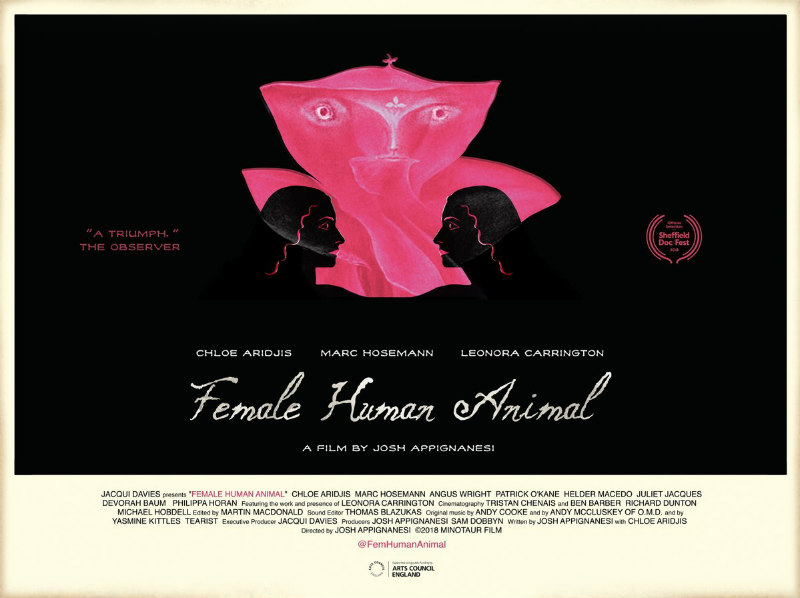
Review by Benjamin Poole
Directed by: Josh Appignanesi
Starring: Chloe Aridjis, Marc Hosemann, Angus Wright

It’s safe to say that Female Human Animal, Josh Appignanesi’s more-art-installation-piece-than-movie-docu-drama, is unlike anything else you’ll see this year. Using pre-existing narrative structures as a canvas to overlay impressionistic sequences of sexual repression, introspection and obsession, the film is the very definition of ‘arty’. To be frank, the film’s oblique idiosyncrasy is so expressly individual that you may not actually want to see Female Human Animal, either. Your loss: for the rest of us this film is a gloriously intense, thrillingly abstract oddity.


Shot upon the glitch and grain of VHS tape, Female Human Animal focuses on a writer, Chloe Aridjis (played by real life novelist Chloe Aridjis), who is curating a Tate retrospective of surrealist artist Leonora Carrington (amazing). In films, female writers are either gloriously kooky (as in romcoms) or lonely and socially maladjusted: guess which Chloe is? Never mind though, because a brooding, Heathcliff figure of a strange man appears - spotted in the recesses of galleries, in shimmering reflections, but encroaching as the film goes - and ignites a sexual awakening in our heroine.
Set within the vivid London art world, the clean white expanses of galleries and the awkward networking that occurs within them, the film is given authentic propinquity by the mode of filming, which rescues VHS and handheld framing from the diminishing returns of found footage horror. Like a painter using oils instead of digital colouring, the texture of VHS has its own charms, and is used here to imbue Chloe’s story, and psychology, with fuzzy edges and an almost sinister air of voyeurism (video breaks the fourth wall: we intuit, mainly through old episodes of 'You’ve Been Framed' and family videos, that anything recorded on this format involves someone holding a camera).

Female Human Animal’s arresting visual style coagulates horror film tropes and documentary approaches to create an evocative and unique mise-en-scene. The descriptor 'Lynchian' is often lazily applied to anything that doesn’t adhere to standard storytelling, but the adjective is applicable here, as in Female Human Animal, just as in Lynch, meaning is created by visual repetitions and a devious juxtaposition of imagery which gives poetic structure to the film’s blend of dreams, stilted conversations and suffocation motifs (anyone who says Lynch’s films are abstruse are not paying close enough attention). As Chloe falls deeper into obsession (with the man, with her curation), Female Human Animal encourages us to look closer at her world and engage in the sort of free associations which art appreciation entails.
Watching Velvet Buzzsaw last night (tbf I did fall asleep midway through, but what I saw seemed like a load of old tosh), it struck me how fruitless the idea of satirising the art world is (unless it involves Dick Miller and his Bucket of Blood - rest in peace fella x). The ‘art world’ is so far beyond satire it’s unreal! Have you seen Karl Lagerfeld? Jeff Koons' pop chicanery? Cy Twombly’s mad scribbles? The scene is replete with knowing, playful idiocy and tongue in cheek approvals, but also, more importantly, extreme beauty, startling concepts and challenges to traditional paradigms. Setting Female Human Animal within its fertile milieus enables the film to explore ideas of reality and interpretation, and how representations of the real are dependent upon individual perception. Chloe Aridjis is ‘real’, yet ‘Chloe’ is a performance. Leonara Carrington existed too and is seen here in elliptical documentary sequences that are testament to epigrammatical brilliance (‘eat, sex, art’ - preach sister), but it is her work which is her existent legacy. There are also cameos from real life academics and the like (including the wonderful Marina Warner: idol), but Chloe’s lechy publisher is a fictional character, and is played by Angus Wright (who did, however, play a character called Angus in Peep Show - spooky). The shifting scape of the film’s fictionality is expressive of Chloe’s mindset, and as the film moves towards its fatal denouements it invites us to play along with its impressionistic suggestions of what is real and what could be a product of its central character’s yearning imagination, which, Female Human Animal, suggests, is where she truly abides.


Towards the end, this defiantly pretentious film about art does wander up its own paint pot, but this is a fitting and inevitable outcome, and does little to diminish Female Human Animal’s strange impacts (mind you, in the final moments there is also an ill-advised and surely accidental homage to American Beauty’s more cringeworthy scene, which had me howling with laughter, albeit good naturedly). Aridji is fantastic, her severe beauty and agitated intelligence anchoring the film to an emotional reality. As Carrington herself expounds when she is discussing the essential humanity of art: "people offer something radically different." Female Human Animal does her proud.

Female Human Animal is in NY/LA cinemas and on MUBI US February. In the UK it can be found on BFIPlayer late February. More info at FemaleHumanAnimal.com

